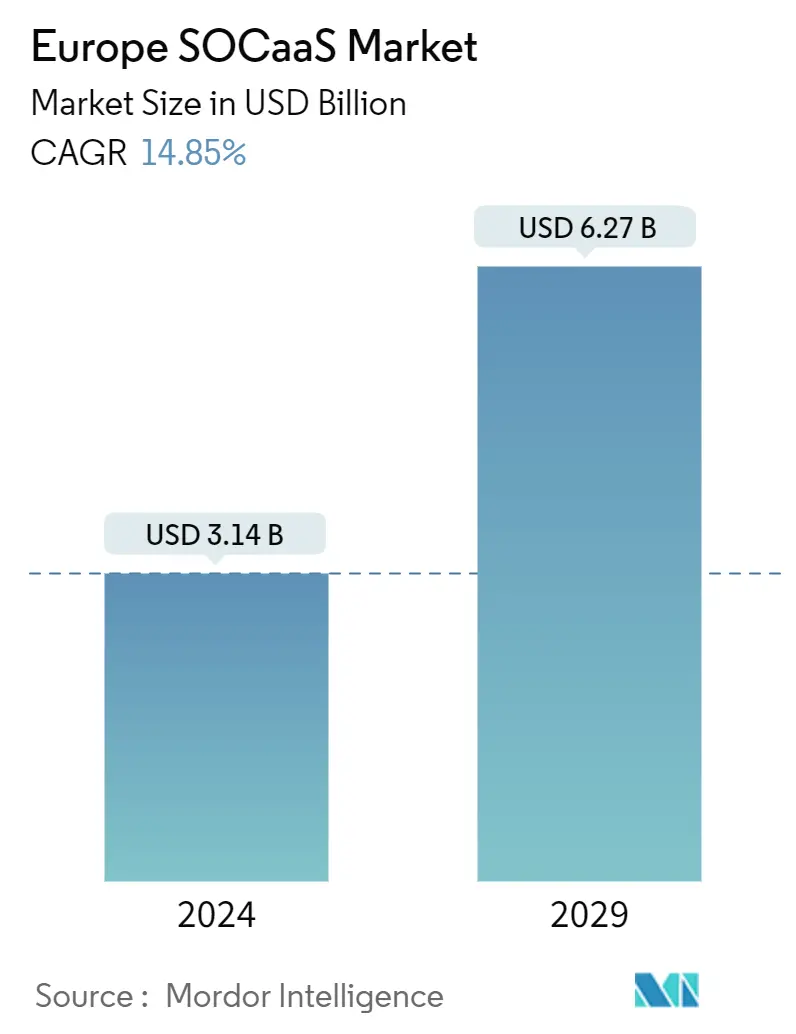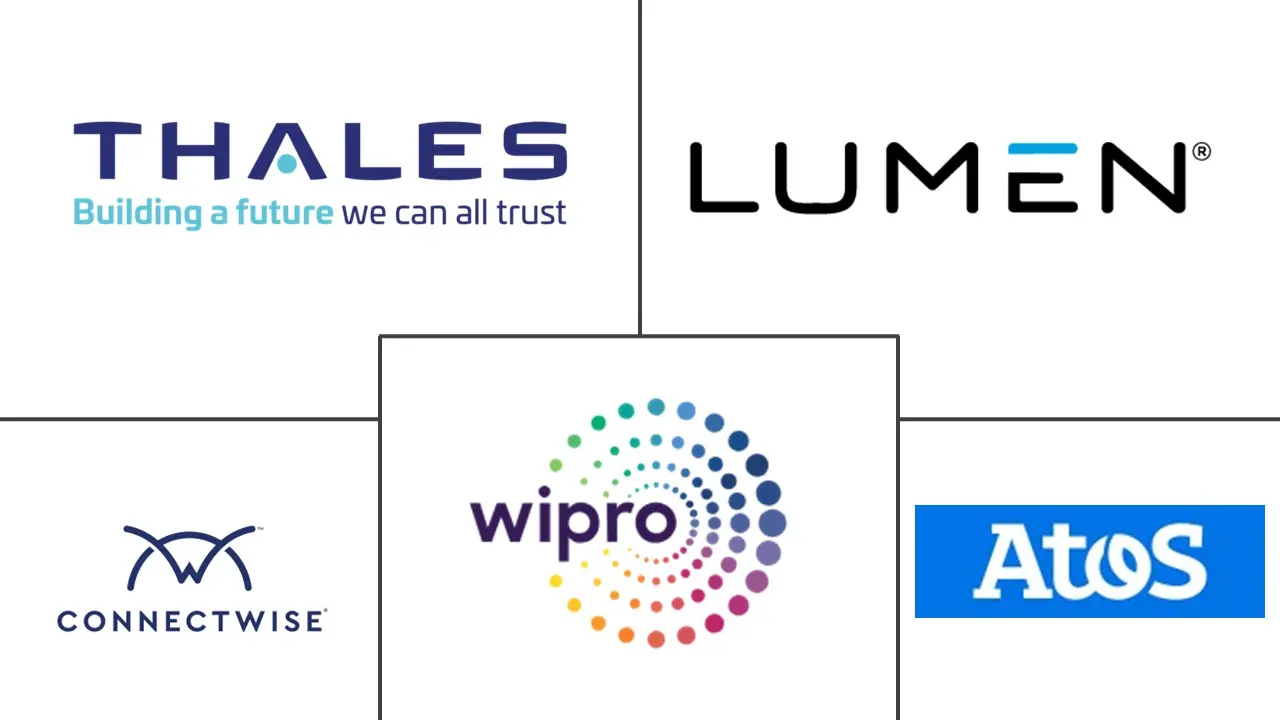Market Size of Europe SOCaaS Industry

| Study Period | 2019 - 2029 |
| Base Year For Estimation | 2023 |
| Market Size (2024) | USD 3.14 Billion |
| Market Size (2029) | USD 6.27 Billion |
| CAGR (2024 - 2029) | 14.85 % |
| Market Concentration | Low |
Major Players
*Disclaimer: Major Players sorted in no particular order |
Europe SOCaaS Market Analysis
The Europe SOCaaS Market size is estimated at USD 3.14 billion in 2024, and is expected to reach USD 6.27 billion by 2029, growing at a CAGR of 14.85% during the forecast period (2024-2029).
As businesses prioritize cybersecurity to protect their digital assets, the market studied has grown significantly in recent years. SOC as a service enables companies to contract out their security operations to specialized service providers by providing an integrated approach to threat detection, incident response, and continuous monitoring.
- Cyberattacks are increasing rapidly across emerging economies in terms of volume and complexity, where incident response units are pushing their limit in terms of time, skill, and resources to obtain actionable measures at the right time to avoid such incidents. At the same time, organizations are encountering an unparalleled number of security threats and risks with increasing numbers of employees, customers, and partners, thereby embracing new trends and innovations through digital transformation.
- The rise in the pay-per-use model adoption due to the capex reduction has emerged as a major driver for adopting SOC-as-a-service in European industries in the past few years. As the need for businesses to strengthen their security landscape rises across sectors, many are turning to pay-per-use subscription models. Over the past couple of years, organizations across sectors have been focusing on opex-first models rather than capex-heavy offerings owing to the reduction in capex.
- The SMEs in the region are rapidly migrating to the cloud owing to the rising need for scalability and flexibility. Cloud computing has enabled a new way of working, allowed more flexible, collaborative, and effective work, and accelerated the delivery of outputs in small and medium-sized enterprises to scale services and capacity up or down as needed without investing in their own infrastructure. As organizations undergo significant cloud deployment, the security vulnerabilities associated with cloud deployment become increasingly evident, driving the demand for managed SOC services.
- To efficiently detect and respond to threats, a SOCaaS vendor will need access to a business’s data. Sharing large amounts of sensitive data could lead to data exposure and higher security risks for organizations. Additionally, SOC service providers will also need permission to store sensitive data. This may expose the organization to data leaks if the provider is compromised. Further, although organizations can typically monitor threat warnings internally, most data processing occurs outside the perimeter, restricting organizations’ ability to store and analyze extensive historical data on identified threats and potential data breaches.
- Innovations and technological advancements in the past few years have revolutionized cybersecurity-related practices in Europe. With the digital transformation, IT and security professionals face one of the most challenging environments, with trends including a massive migration to public clouds, the adoption of Big Data analytics, machine learning, and Artificial Intelligence, and the emergence of Industry 4.0 and the (industrial) Internet of Things.
Europe SOCaaS Industry Segmentation
The study tracks the revenue accrued through the fully managed SOC services to manage network, cloud, or end-point protection offered through the cloud on the subscription-based model in Europe. The study also focuses on further analysis of specific countries in the region.
The study includes market estimates and growth forecast, segment-level analysis (end-users and organization size), overall estimates and end-user ranking analysis for countries, and further details around trends and developments. However, the study does not include pricing model analysis, information related to potential SOC sites in the country, market share analysis of competitors, and details about customer personas. The analysis is based on the market insights captured through secondary research and the primaries. The market also covers the major factors impacting its growth in terms of drivers and restraints.
The Europe SOC-as-a-Service Market is segmented by organization size (SMEs, large enterprises), by end-user (IT and telecom, BFSI, retail and consumer goods, healthcare, manufacturing, government, other end users), by country (United Kingdom, Germany, France, Italy, Spain, Austria, Nordics, Benelux, Rest of Europe). The market sizes and forecasts are provided in terms of value in USD for all the above segments.
| By Organization Size | |
| SMEs | |
| Large Enterprises |
| By End User | |
| IT and Telecom | |
| BFSI | |
| Retail and Consumer Goods | |
| Healthcare | |
| Manufacturing | |
| Government | |
| Other End Users |
| By Country | |
| United Kingdom | |
| Germany | |
| France | |
| Italy | |
| Spain | |
| Austria | |
| Nordics | |
| Benelux |
Europe SOCaaS Market Size Summary
The Europe SOC-as-a-Service market is experiencing significant growth as businesses increasingly prioritize cybersecurity to safeguard their digital assets. This market expansion is driven by the rising complexity and volume of cyberattacks, prompting organizations to outsource their security operations to specialized service providers. The adoption of pay-per-use models has become a key trend, allowing companies to reduce capital expenditures by shifting towards operational expenditure-focused subscriptions. This shift is particularly evident among small and medium-sized enterprises (SMEs) that are migrating to cloud solutions for enhanced scalability and flexibility. As digital transformation accelerates, the demand for managed SOC services is rising, driven by the need to address security vulnerabilities associated with cloud deployments.
In the retail sector, the surge in online shopping and e-commerce has heightened the demand for SOC-as-a-Service to protect consumer and business data from cyber threats. The European Union's updated NIS2 regulation further underscores the importance of robust cybersecurity measures across industries. Major players in the market, such as Thales, Connectwise LLC, Atos SE, Lumen Technologies, and Wipro, are leveraging partnerships and acquisitions to enhance their offerings and maintain a competitive edge. Innovations in cybersecurity, including the integration of AI and machine learning, are reshaping the landscape, particularly in Germany, where the interconnectedness of industrial systems poses unique challenges. The market's growth is supported by strategic collaborations and technological advancements, enabling organizations to proactively detect and respond to cyber threats.
Europe SOCaaS Market Size - Table of Contents
-
1. MARKET INSIGHTS
-
1.1 Market Overview
-
1.2 An Assessment of the Impact of and Recovery from COVID-19
-
1.3 Impact of Macroeconomic Trends on the Industry
-
-
2. MARKET SEGMENTATION
-
2.1 By Organization Size
-
2.1.1 SMEs
-
2.1.2 Large Enterprises
-
-
2.2 By End User
-
2.2.1 IT and Telecom
-
2.2.2 BFSI
-
2.2.3 Retail and Consumer Goods
-
2.2.4 Healthcare
-
2.2.5 Manufacturing
-
2.2.6 Government
-
2.2.7 Other End Users
-
-
2.3 By Country
-
2.3.1 United Kingdom
-
2.3.2 Germany
-
2.3.3 France
-
2.3.4 Italy
-
2.3.5 Spain
-
2.3.6 Austria
-
2.3.7 Nordics
-
2.3.8 Benelux
-
-
Europe SOCaaS Market Size FAQs
How big is the Europe SOCaaS Market?
The Europe SOCaaS Market size is expected to reach USD 3.14 billion in 2024 and grow at a CAGR of 14.85% to reach USD 6.27 billion by 2029.
What is the current Europe SOCaaS Market size?
In 2024, the Europe SOCaaS Market size is expected to reach USD 3.14 billion.

